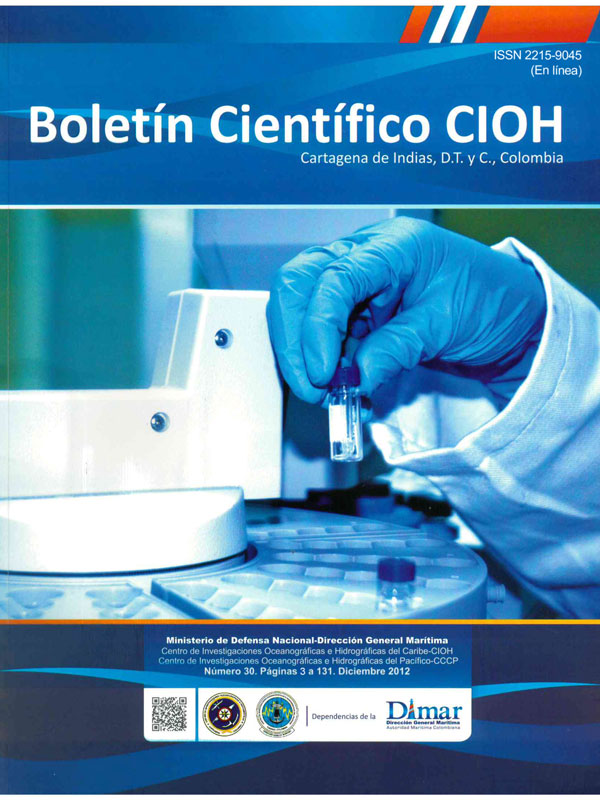Variability of physic-chemical parameters on oceanic station in front of the Tumaco Bay
DOI:
https://doi.org/10.26640/22159045.246Keywords:
physicochemical variables, nutrients, oceanic station, Tumaco BayAbstract
The information obtained of the monitoring realized fortnightly periodicity an oceanic station, located in the southern Colombian Pacific, specifically in front Tumaco Bay, it was evaluated the temporal behavior of some physicochemical variables (salinity, temperature, dissolved oxygen), chlorophyll a and nutrients (ammonia, nitrites, nitrates, phosphates and silicates), during the period between 2007 and 2011, in order to contribute to knowledge about changes in the pattern of behavior that can be submitted to the occurrence of events or phenomena that are relevant for the region. Its geographical location consolidates as an indicator of the variability of oceanographic parameters, since meteomarine is influenced by factors associated with the Intertropical Convergence Zone -ITCZ, the wind direction and current Colombia. In this respect, a marked change in the behavior of the isotherms, isohalines and the physicochemical parameters of the water column was presented during the first quarter of each year, registering between the surface and 20 m, a delta average of 7,9 °C for temperature and 2,8 psu to salinity, due to the emergence of subsurface cold waters caused by deep currents and favored by the direction of the winds, which at the season are in the northeast due to the movement of the ITCZ; this led to an increase the concentrations of dissolved inorganic nutrients, which reached levels of 1,94 in at P-(PO4)-3/L for phosphates; 4,65 pg at N-NH4+/L for ammonium, and repeatedly aboye 10 pg at N-NO3-/L for nitrate, values higher than those usually found at the point of study, the changes in the physicochemical conditions of the area were more intense during March and April 2009; as in January and February 2011, also manifested with increased chlorophyll a concentrations with values up to 2,35 mg/m3 and a decrease in dissolved oxygen levels, at times falling below 2,5 mg 02/L.Downloads
References
[2] Rodríguez-Rubio, E., Schneider, W. y Abarca del Río, R. On the seasonal circulation within Panama Bight derived from satellite observations of winds, altimetry and sea surface temperature. Geophys Res Lett. 2003; 30: 1410-1413.
[3] Rueda Bayona, J., Rodríguez-Rubio E y Ortiz J. Caracterización espacio temporal del campo de vientos superficiales del Pacífico colombiano y el golfo de Panamá a partir de sensores remotos y datos in situ. Boletín Científico CCCP. 2007; (14): 49-68.
[4] Zea, J.A. Baja Anclada del Pacífico. Meteorología Colombiana. 2003; 7: 109- 116.
[5] Rodríguez Rubio, E. y Giraldo López, A. Surgencia oceánica en el Pacífico colombiano durante febrero–marzo de 1997: aproximación oceanográfica utilizando sensores remotos. IX Congreso Latinoamericano sobre Ciencias del Mar, San Andrés Isla; 2001.
[6] Bubnov, V.A. Circulación de las Aguas de la Zona Ecuatorial del Océano Mundial. Leningrado Hidrometeoizdat. 1990.
[7] CCCP. Centro de Investigaciones Oceanográficas e Hidrográficas del Pacífico. Compilación Oceanográfica de la Cuenca Pacífica Colombiana. Serie de Publicaciones Especiales Vol. 1, Centro Control Contaminación del Pacífico-CCCP, Dimar, Tumaco, Colombia. 2002.
[8] Corporación Andina de Fomento. El fenómeno El Niño 1997-1998. Memoria: Retos y Soluciones. Vol. IV: Ecuador 2000. 304 pp.
[9] Garreaud, R., Vuille, M., Compagnucci, R. y Marengo, J. Present-day South American Climate. PALAEO3 Especial Issue (LOTRES South America). 2009; 281 (3-4): 180-195.
[10] Bastidas Pantoja, G.D. Evaluación temporal de parámetros fisicoquímicos en una estación oceánica frente a la Bahía de Tumaco. Boletín Científico CIOH. 2011; 29: 137-145.
[11] Strickland, J.D.H. y Parsons, T.R. A practical handbook of seawater analysis. 2nd ed. J. Fish. Res. Bd. Canada. 1972.
[12] Bendschneider, K. y Robinson, R.J. A new Spectrophotometric Method for the determination of nitrite in sea water. J Mar Res. 1952; 11: 87-96.
[13] Murphy, J. y Riley, J.P. A single-solution method for determination of soluble phosphate in sea water. J. mar. boil. Ass. 1958; 37: 9–14.
[14] APHA, AWWA, WEF. Standard methods for the examination of water and wastewater. 21th Ed. Washington, American Public, Health Association. 2005.
[15] Stevenson, M.R., Guillen, G.O. y Santoro de Ycaza, J.S. Marine atlas of the Pacific coastal waters of South America. Berkeley. University of California Press. 1970.
[16] Cruz, M., Tapia, M.E. y Naranjo, C. Especies planctónicas marinas como bioindicadoras de masas de agua frente a la costa ecuatoriana durante el evento El Niño 2009 – 2010. Acta Oceanográfica del Pacífico. 2011; 16 (1): 11-23.
[17] Díaz, D., Málikov, I. y Villegas, N. Características de las zonas de surgencia de la cuenca del Pacífico colombiano y su relación con la Zona de Convergencia Intertropical. Boletín Científico CIOH. 2008; (26): 59-71.
[18] Transmonte, G. y Silva, Y. Evento La Niña: propuesta de definición y clasificación según las anomalías de temperatura de la superficie del mar en el área Niño 1+2. Inf. Inst. Mar Perú. 2008; 35 (3): 199 – 208.
[19] EPA. Developing and Implementing an Estuarine Water Quality Monitoring, Assessment, and Outreach Program The MYSound Project, EPA/625/R-02/010 November 2002.
[20] NOAA. Quality control and processing of historical oceanographic nutrient data. Washington, D.C. 1994. April. Technical Report Nesdis 79.
[21] Rodríguez-Rubio. E. y Stuardo, J. Variability of photosynthetic pigments in the Colombian Pacific Ocean and its relationship with the wind field using ADEOS-I data. P. Indian Acad. Sci. (EarthPlanet Sci.). 2002; 111 (3): 227-236.
Downloads
Published
Issue
Section
License
Attribution — You must give appropriate credit, provide a link to the license, and indicate if changes were made. You may do so in any reasonable manner, but not in any way that suggests the licensor endorses you or your use.
NonCommercial — You may not use the material for commercial purposes.
NoDerivatives — If you remix, transform, or build upon the material, you may not distribute the modified material.
No additional restrictions — You may not apply legal terms or technological measures that legally restrict others from doing anything the license permits.



